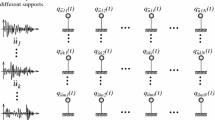Abstract
Fundamental principles from structural dynamics, random theory and perturbation methods are adopted to develop a new response spectrum combination rule for the seismic analysis of non-classically damped systems, such as structure-damper systems. The approach, which is named the perturbation spectrum method, can provide a more accurate evaluation of a non-classically damped system’s mean peak response in terms of the ground response spectrum. To account for the effect of non-classical damping, all elements are included in the proposed method for seismic analysis of structure, which is usually approximated by ignoring the off-diagonal elements of the modal damping matrix. Moreover, as has been adopted in the traditional Complete Quadratic Combination (CQC) method, the white noise model is also used to simplify the expressions of perturbation correlation coefficients. Finally, numerical work is performed to examine the accuracy of the proposed method by comparing the approximate results with exact ones and to demonstrate the importance of the neglected off-diagonal elements of the modal damping matrix. In the examined cases, the proposed method shows good agreement with direct time-history integration. Also, the perturbation spectrum method leads to a more efficient and economical calculation by avoiding the integral and complex operation.
Similar content being viewed by others
References
Antonio, O., 2009. Additional viscous dampers for civil structures analysis of design methods based on effective evaluation of modal damping ratios. Engineering Structures, 31(5):1093–1101. [doi:10.1016/j.engstruct.2009.01.006]
Bilbao, A., Avilés, R., Agirrebeitia, J., Ajuria, G., 2006. Proportional damping approximation for structures with added viscoelastic dampers. Finite Elements in Analysis and Design, 42(6):492–502. [doi:10.1016/j.finel.2005.10.001]
Cortés, F., Elejabarrieta, M.J., 2006. Computational methods for complex eigenproblems in finite element analysis of structural systems with viscoelastic damping treatments. Computer Methods in Applied Mechanics and Engineering, 195(44–47):6448–6462. [doi:10.1016/j.cma.2006.01.006]
Elishakaff, I., Lyon, H.R., 1986. Random Vibration-status Recent Developments. Elsevier Science Publishers, New York.
Heredia-Zavoni, E., Pérez-Pérez, A., Barranco-Cicilia, F., 2006. A method for the transfer function matrix of combined primary-secondary systems using classical modal decomposition. Earthquake Engineering and Structural Dynamics, 35(2):251–266. [doi:10.1002/eqe.525]
Ibrahtmbegovic, A., Wilson, E.L., 1989. Simple numerical algorithms for the mode superposition analysis of linear structural systems with non-proportional damping. Computers and Structures, 33(2):523–531. [doi:10.1016/0045-7949(89)90026-6]
Khanlari, K., Ghafory-Ashtiany, M., 2005. New approaches for non-classically damped system eigenanalysis. Earthquake Engineering and Structural Dynamics, 34(9):1073–1087. [doi:10.1002/eqe.467]
Kim, C.W., Bennighof, J.K., 2006. Fast frequency response analysis of partially damped structures with non-proportional viscous damping. Journal of Sound and Vibration, 297(3–5):1075–1081. [doi:10.1016/j.jsv.2006.04.029]
Kiureghian, D.A., Nakamura, Y., 1993. CQC modal combination rule for high-frequency modes. Earthquake Engineering and Structural Dynamics, 22(11):943–956. [doi:10.1002/eqe.4290221103]
Lin, F.B., Wang, Y.K., Cho, Y.S., 2003. A pseudo-force iterative method with separate scale factors for dynamic analysis of structures with non-proportional damping. Earthquake Engineering and Structural Dynamics, 32(2):329–337. [doi:10.1002/eqe.234]
Lin, J.H., 1992. A fast CQC algorithm of PSD matrices for random seismic responses. Computers and Structures, 44(3):683–687. [doi:10.1016/0045-7949(92)90401-K]
Lou, M.L., Chen, G.D., 2003. Modal perturbation method and its applications in structural systems. Journal of Engineering Mechanics, ASCE, 169(8):935–943. [doi:10.1061/(ASCE)0733-9399(2003)129:8(935)]
Shahruz, S.M., Mahavamana, P.A., 1998. An upper bound on response of non-classically damped linear systems. Journal of Sound and Vibration, 218(5):883–891. [doi:10.1006/jsvi.1998.1791]
Yu, R.F., Zhou, X.Y., 2007. Simplifications of CQC method and CCQC method. Earthquake Engineering and Engineering Vibration, 6(1):65–75. [doi:10.1007/s11803-007-0640-7]
Zhou, X.Y., Yu, R.F., Dong, D., 2004. Complex mode superposition algorithm for seismic responses of non-classically damped linear MDOF system. Journal of Earthquake Engineering, 8(4):597–641. [doi:10.1080/13632460409350503]
Author information
Authors and Affiliations
Corresponding author
Additional information
Project supported by the Program for Changjiang Scholars and Innovative Research Team in University (No. IRT0518), and the Program of Introducing Talents of Discipline to Universities (No. B08014), China
Rights and permissions
About this article
Cite this article
Guo, W., Li, Hn. & Guo, Z. Perturbation spectrum method for seismic analysis of non-classically damped systems. J. Zhejiang Univ. Sci. A 11, 325–334 (2010). https://doi.org/10.1631/jzus.A0900155
Received:
Accepted:
Published:
Issue Date:
DOI: https://doi.org/10.1631/jzus.A0900155
Key words
- Seismic response
- Non-classical damping
- Perturbation technique
- Response spectrum method
- Forced decoupling method
- Pseudo excitation




